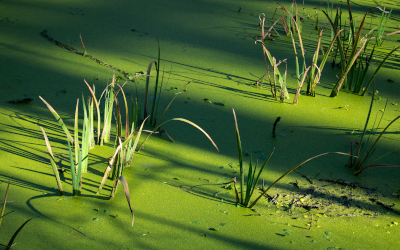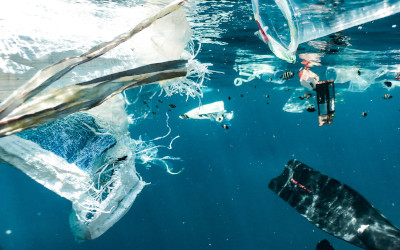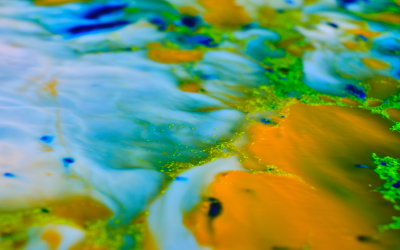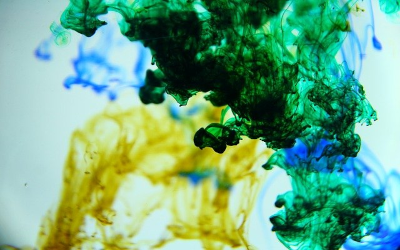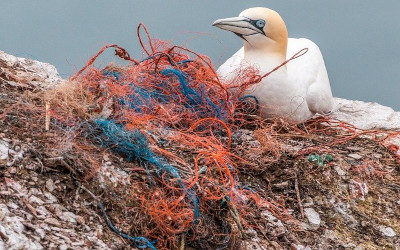
Diving Into the Ecosystem Impacts of Clothing
Water is all around us. It ripples in our lakes and ponds. It rushes as streams and rivers and it fills our bathtubs and washing machines. Water forms the spring rain that helps plants to grow and the evening tide that crashes onto the sand. Water supports all life on Earth, from billions of humans, animals and plants, to the tiniest bacteria.
So, if water is so important, why are we poisoning it?
From in the Noyyal River to microplastic pollution in your own community, water all over the world is being polluted by clothing. Water pollution is a threat to human health. It is also a serious threat to ecosystems.
What water sources are impacted by textile pollution?
Rivers & Streams
Point source pollution is when textile factories use clean water from rivers and streams to dye and treat clothing. Then they dump full of toxic chemicals and heavy metals back into waterways.

Shown is a colour illustration of three factories with large pipes pouring colourful liquid into a river.
There are three buildings with tall windows and smokestacks along a river bank. Two are grey and one is brown. Each one has a large grey pipe extending from the front wall into the river. The liquid from the first factory is pink, the second is orange, and the third is yellow. All the colourful liquid combines as it flows down in the blue river.
Image - Text version
Shown is a colour illustration of three factories with large pipes pouring colourful liquid into a river.
There are three buildings with tall windows and smokestacks along a river bank. Two are grey and one is brown. Each one has a large grey pipe extending from the front wall into the river. The liquid from the first factory is pink, the second is orange, and the third is yellow. All the colourful liquid combines as it flows down in the blue river.
Dye pollution from clothing factories (©2021 Let’s Talk Science)
Oceans & Lakes
The textile industry pollutes oceans and lakes mainly through its activities on land. Textile factories and farms pollute rivers and streams with chemicals and heavy metals. Then these waterways carry the pollution downstream to oceans and lakes.
Microplastics end up in oceans and lakes because we wash them downstream with our . They can also enter storm drains or get blown into the water.
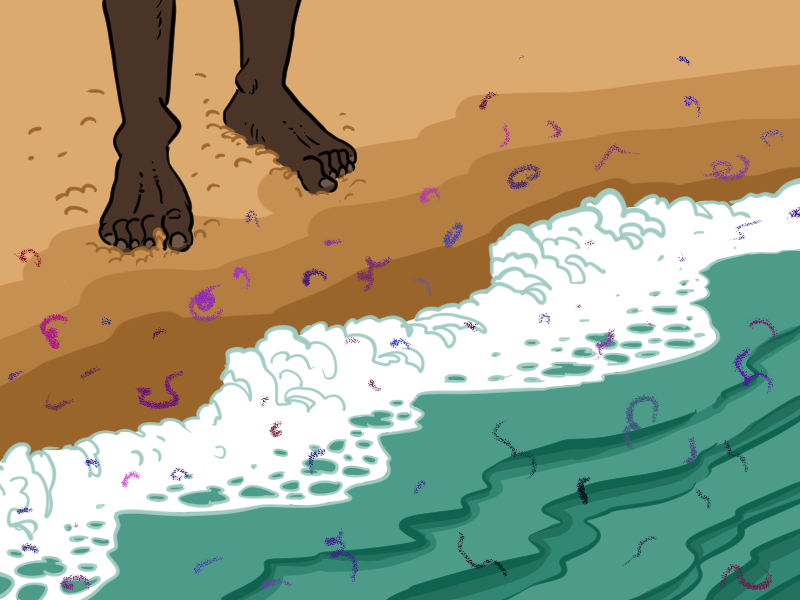
Shown is a colour illustration of bare feet on a beach.
In the top left, a pair of bare feet with dark brown skin is shown from the mid-calf down. The person is digging their toes into beige sand. Below, the sand gets darker as it gets closer to the water. Greenish blue waves wash up on the sand. These create a strip of white foam and bubbles, diagonally across the picture.
Image - Text version
Shown is a colour illustration of bare feet on a beach.
In the top left, a pair of bare feet with dark brown skin is shown from the mid-calf down. The person is digging their toes into beige sand. Below, the sand gets darker as it gets closer to the water. Greenish blue waves wash up on the sand. These create a strip of white foam and bubbles, diagonally across the picture.
Microplastics wash up on the beach (©2022 Let’s Talk Science)
Groundwater
Groundwater is water in cracks and spaces underground. This is polluted when waste from textile farming, factories and landfills into the soil and contaminates the groundwater below.
Many people use groundwater from wells or springs. This may be their only source of water. Once groundwater becomes polluted it is very hard to remove the pollutants. This can mean water becomes toxic for humans and other living things.
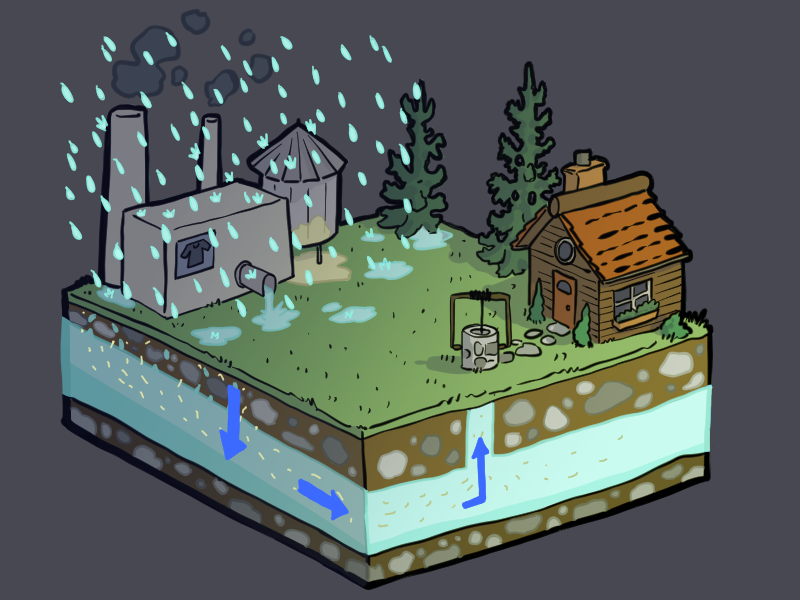
Shown is a colour illustration of a factory and a house, and the underground water below both.
A square piece of land is sliced like a cake. It floats on a dark grey background. The top layer is green grass. A grey factory is on one corner, and a house with a well is on the other. Below is a layer of rock and soil, a layer of blue water, then more rock and soil.
On the surface, rain falls over the factory and puddles on the ground. More water pours out of a pipe on the front of the building. Yellow liquid also leaks out of the factory, forming a puddle. Below the surface, a blue arrow indicates water and tiny yellow particles leaching through the ground and into the water underneath.
Another blue arrow shows the contaminated water from the factory is flowing underneath the house. Under the well, a third blue arrow shows the same water coming up to the surface.
Image - Text version
Shown is a colour illustration of a factory and a house, and the underground water below both.
A square piece of land is sliced like a cake. It floats on a dark grey background. The top layer is green grass. A grey factory is on one corner, and a house with a well is on the other. Below is a layer of rock and soil, a layer of blue water, then more rock and soil.
On the surface, rain falls over the factory and puddles on the ground. More water pours out of a pipe on the front of the building. Yellow liquid also leaks out of the factory, forming a puddle. Below the surface, a blue arrow indicates water and tiny yellow particles leaching through the ground and into the water underneath.
Another blue arrow shows the contaminated water from the factory is flowing underneath the house. Under the well, a third blue arrow shows the same water coming up to the surface.
Leaching (©2022 Let’s Talk Science)
Rainwater
Microplastics are tiny fibres shed from synthetic clothing. They are so small and lightweight that they are carried upward with evaporated water. Then they fall down again with rain or snow.
This means microplastics can travel vast distances. They are even found in places where no humans live.

Shown is a colour illustration of rain, magnifying one drop to show a microplastic particle.
Pale blue raindrops fall in front of a dark blue background. They splash down onto a greenish yellow umbrella. A close-up of one drop is shown in an image bubble. There is a tiny purple squiggle inside.
Image - Text version
Shown is a colour illustration of rain, magnifying one drop to show a microplastic particle.
Pale blue raindrops fall in front of a dark blue background. They splash down onto a greenish yellow umbrella. A close-up of one drop is shown in an image bubble. There is a tiny purple squiggle inside.
Microplastics in rain water (©2022 Let’s Talk Science)
How are ecosystems impacted by water pollution?
Water pollution impacts all kinds of ecosystems. But aquatic ecosystems are directly affected. Click on this picture of an aquatic ecosystem to understand the impacts.
Image - Text version
Shown is a colour illustration of an underwater scene with live fish, dead fish, plants, and microplastics.
There is a thin strip of blue sky and clouds across the top of the panel. Below, the water is shaded from blueish green at the top, to deep pink at the bottom. The ocean floor is covered with plants is shades of green and purple.
Two fish float belly-up near the surface of the water. There are bright pink Xs over their eyes. The water is sprinkled with brightly coloured squiggles of microplastic. Fish of several different shapes and sizes swim through the microplastic.
Item Descriptions
Microplastics
Tiny pieces of plastic come off synthetic clothing in the wash. These microfibres are so small that many aquatic animals will eat them by accident. Eating microfibres can make birds, turtles and fish sick, or even kill them.
Dye pollution
When textile manufacturers dump
containing dye directly into lakes and rivers, it can change the colour of the water. If the colour changes enough, sunlight cannot pass through the water. This reduces plants' ability to photosynthesize. Without photosynthesis, oxygen levels in the water drop. This can kill plants and animals in the water.
Chemicals in Water (fish)
Hazardous chemicals released into the water can kill plants and animals. This results in lower population numbers and less biodiversity in aquatic ecosystems
It can be difficult to remove toxic chemicals from water. So, they may end up in the water we drink and the food we eat. This can make humans very sick.
Dead plants
Chemicals and dyes kill aquatic plants like algae. When these plants decay, they release methane and hydrogen sulphide gas. Methane is a greenhouse gas, and hydrogen sulphide is poisonous in high concentrations.
Eutrophication
The layer of scum on top of the water is a result of
. Eutrophication is when algae grows faster than normal. This can cause aquatic animals and plants to die.
Going Deeper About Eutrophication
Have you ever seen a layer of green scum on a lake? This scum is because of the process of eutrophication. Eutrophication happens when there is too much phosphorus and nitrogen in the water. This causes algae to grow faster than normal. Too much algae can cause serious problems like:
- can kill fish and other aquatic life
- Less biodiversity of plants and animals
- Threatening the safety of drinking water
Sometimes eutrophication happens naturally. But humans cause .
What is Eutrophicaton? (1:03) USOCEANGOV (2018)
The fashion industry adds phosphorus and nitrogen to water systems. One way is through the use of chemical fertilizers on crops such as cotton. Another is in from textile factories. We even add these chemicals to water systems when we wash our clothes with detergent. All of these things cause .
Making Waves Against Water Pollution
So what are people doing to protect our water and ecosystems? Young people across Canada are taking action to fight against water pollution from textile and other industries. Here are some examples.
A group of students from the University of Sherbrooke started Hoola One, a company that designs special vacuums to clean up microplastics. Three of their current projects include the HO Micro, the HO Wrack and the HO backpack. Hoola One’s mission is to restore ecosystems affected by plastic pollution.
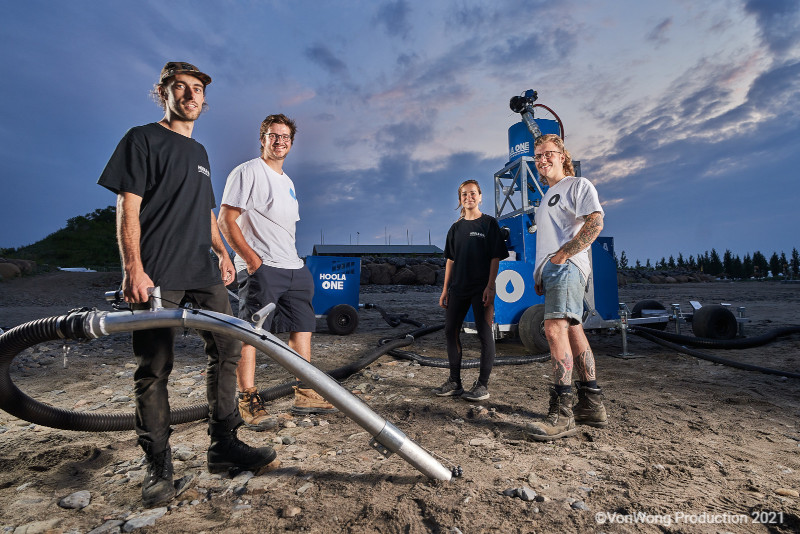
Shown is a colour photograph of four people next to a large machine that looks like a vacuum cleaner.
One person, in the foreground, on the left, is holding a long, thick silver pipe with a handle at the base. This is attached to a black hose that curls behind the group. This is attached to the top of a large blue structure, about twice the height of the people. On the side of this is a logo of a white circle with a blue water droplet in the centre. Nearby, a smaller blue, square object, on wheels, is printed with white letters that read Hoola One.
Image - Text version
Shown is a colour photograph of four people next to a large machine that looks like a vacuum cleaner.
One person, in the foreground, on the left, is holding a long, thick silver pipe with a handle at the base. This is attached to a black hose that curls behind the group. This is attached to the top of a large blue structure, about twice the height of the people. On the side of this is a logo of a white circle with a blue water droplet in the centre. Nearby, a smaller blue, square object, on wheels, is printed with white letters that read Hoola One.
HoolaOne Team (©VonWong Production 2021)
Autumn Peltier is known as the “Water Protector”. She is a teenage activist who fights for water rights for Indigenous peoples. Peltier is from the Wiikwemkoong First Nation on Manitoulin Island in Ontario. She has been nominated for the International Children’s Peace Prize three times.
At the age of 12, Peltier came face to face with Prime Minister Justin Trudeau at an International Assembly. She gained international attention for the way she criticized his decisions and asked him for answers.
At the age of 16, Peltier was made Chief Water Commissioner by the Anishinabek Nation. She has spoken in front of world leaders, and at the United Nations to demand clean drinking water on Indigenous reserves.
Peltier is one of the leading youth environmental activists in the world. In 2021, she won the Planetary Health Award from the Prince Albert II Foundation of Monaco. She has been a keynote speaker at the World Economic Forum. Her name has been included on Maclean’s Magazine’s “Power List - Top 50 Canadians” and Elle Magazine’s “15 Indigenous People to Know in Canada”.
In 2019, Peltier’s short film The Water Walker received global attention. It followed her journey to speak at the United Nations at the age of 13. The film is now featured on HBO Canada.
Autumn Peltier is currently petitioning for clean, accessible drinking water for every person in Canada.
Shown is a black and white photograph of a young person looking straight into the camera. Dark liquid runs down her face.
The photograph shows only half Autumn Peltier's face, set against a dark background. She is looking straight at the viewer. Thick dark liquid runs from both sides of her eye, down her cheek to her jaw and the corner of her lip. More liquid runs from under her bottom lip to her chin. A pale, circular earring hangs from her ear. Behind it, a braid wrapped in a strip of dark grey fabric falls down past the bottom edge of the photograph.
Image - Text version
Shown is a black and white photograph of a young person looking straight into the camera. Dark liquid runs down her face.
The photograph shows only half Autumn Peltier's face, set against a dark background. She is looking straight at the viewer. Thick dark liquid runs from both sides of her eye, down her cheek to her jaw and the corner of her lip. More liquid runs from under her bottom lip to her chin. A pale, circular earring hangs from her ear. Behind it, a braid wrapped in a strip of dark grey fabric falls down past the bottom edge of the photograph.
Autumn Peltier (© Autumn Peltier, shot by Linda Roy Irevaphotography, 2021)
A group of students at the University of Ottawa wanted to create a sustainable way to address the water crisis affecting indigenous communities across the country so they started Project Nibi. Project Nibi believes that access to safe drinking water is a human right.
“Nibi works with communities to test their water, identify purification solutions and create workshops to allow community members to monitor and take ownership of their drinking water” - Project Nibi
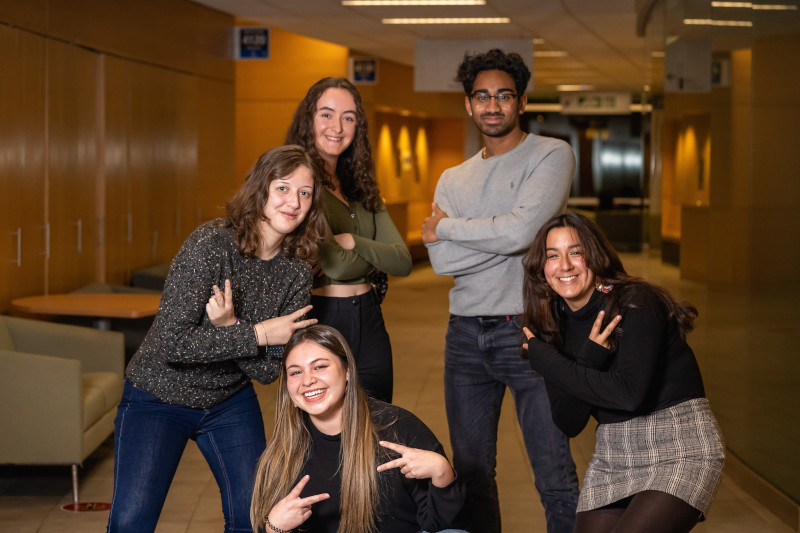
Shown is a colour photograph of five young people smiling and posing for the camera.
They are posing in the hallway of a building. Three people in front crouch or bend low, holding up the first two fingers of each hand in a V shape. Two people at the back stand upright with their arms crossed. All are smiling and looking into the camera.
Image - Text version
Shown is a colour photograph of five young people smiling and posing for the camera.
They are posing in the hallway of a building. Three people in front crouch or bend low, holding up the first two fingers of each hand in a V shape. Two people at the back stand upright with their arms crossed. All are smiling and looking into the camera.
Project Nibi Team (© Nibi, 2021)
Riparia is a charity that offers free outdoor science programming for Indigenous and non-Indigenous young women focused on water. Riparia has a mission to provide hands-on learning experiences for young women that will leave them with the skills and passion to protect all waters.
Shown is a colour photograph of adults and children gathered around a picnic table, looking at fish.
The group is surrounded by forest. There are three adults on one side of the table, and four children on the other. Everyone is wearing gloves. On the table are four brightly coloured cutting boards. A large fish lies on each one. There are drawings of fish on both ends of the table. In the middle, there is one knife, and several other tools.
Image - Text version
Shown is a colour photograph of adults and children gathered around a picnic table, looking at fish.
The group is surrounded by forest. There are three adults on one side of the table, and four children on the other. Everyone is wearing gloves. On the table are four brightly coloured cutting boards. A large fish lies on each one. There are drawings of fish on both ends of the table. In the middle, there is one knife, and several other tools.
Learn all about fish with Riparia (© Mikayla Wujec)
Want to get involved in an organization that is working to protect water? Check out the Promote a movement action!
